The power of a three-phase meter is mainly determined by the current specification and model of the three-phase meter and the voltage required for on-site work. If it is a DC power meter, the power P=I currentU working voltage3, let us give an example below.
Transformer
If the current specification and model of a three-phase meter is 40A and the working voltage on the spot is 380V, then the power P=40A380V3=45600W, why should it be multiplied by a 3, because it is a three-phase meter, 40A*380V only has one phase line Therefore, the three-phase power should be multiplied by 3 as much as possible. The number of three-phase direct-input meters can guarantee up to 100A. Therefore, the direct-input meters are very large, and the power can only shoulder the power of 114000W. If it is as high as this power Otherwise, the direct-entry three-phase meter cannot comply with the regulations. Everyone try to use the transformer-type meter.
Transformer-type electric meters do not limit the power, only the multiplier of the transformer is required to ensure compliance. It is possible to do as much power as you want. For example, what should we do if we want to accurately measure the power of 200,000 W, the current of the general transformer type The specification model is 1.5(6)A, we can first measure the current, I=P/U=200000W/220V≈53A, then you can use a transformer to change the current into the current within the detection range of the meter, a transformer type meter The current range is generally 1.5 to 6A. If the current is changed to 5A, 10 times the transformer should be used as much as possible. Therefore, to accurately measure the power of 200,000, only 10 times the transformer is enough.




